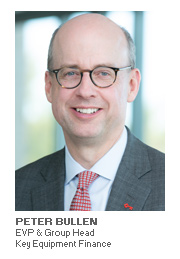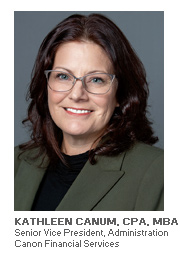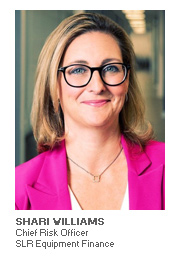
According to the 2024 Equipment Leasing & Finance U.S. Economic Outlook Q2 Update, released by the Equipment Leasing & Finance Foundationin April, real equipment and software investment growth is projected to be 2.2 percent in 2024. The report further states investment activity is expected to pick up in the latter half of 2024 and forecasts real GDP growth of 2.3 percent this year, an improvement over the 1.7 percent growth forecasted in the Foundation’s 2024 Economic Outlook published in December 2023. Additionally, the report indicates that business lending standards for Commercial and Industrial loans tightened in Q4 2023 with a net 15 percent of banks reporting tightening standards for loans to large- and middle-market firms, and 19 percent reporting tighter standards for loans to smaller firms.

Equipment Finance Advisor meets with three leaders from different sectors within the equipment finance industry. The purpose of these dialogues was to gain insights into their perspectives on this latest industry report and to illuminate the anticipated direction of the equipment finance sector. Participants in this dialogue include Peter Bullen, Executive Vice President & Group Head with Key Equipment Finance (Bank-owned); Kathleen Canum, Senior Vice President of Administration with Canon Financial Services (Captive); and Shari Williams, Chief Risk Officer with SLR Equipment Finance (Independent).
Equipment Finance Advisor: How would you describe current credit standards within your company and among your competitors – have they tightened over the past 6 months? What are you seeing in the marketplace?
Peter Bullen: Credit standards have begun to tighten throughout the financial services industry and our company is no exception. While delinquencies remain below historical standards, they are beginning to rise, and certain segments of the economy are starting to soften. Some financial institutions are responding by reducing credit hold levels or placing more focus on fixed charge ratios in making credit decisions. In addition, Federal Regulators are strongly encouraging banks to quickly downgrade credits at the first hint of financial stress. All of this has a chilling effect on the extension of credit.

Kathleen Canum: We do not see much of a change in credit standards for office imaging equipment; however, we do see changes in areas like healthcare. Our standards have tightened as have those in the marketplace. Deals are harder to place than in the previous six months.
Shari Williams: SLR Equipment Finance transitioned its lending practice over the course of the last few years from its legacy business, and as a result has tightened credit standards to emphasize critical factors such as credit quality, cash flow and leverage for example while still balancing the quality of collateral into the overall transaction profile. The company has used the last 12 months as an opportunity to overhaul credit and portfolio management policy and procedures to optimize effectiveness and efficiency in the business. The transformation of our credit philosophy was consciously done to ensure adequate portfolio sustainability and growth over the long-haul. The company also added a third channel to its exiting platform and formally entered the vendor finance space in 2023. Therefore, SLR Equipment Finance has been focused on creating a stable balance between implementing the proper level of credit controls with the desire to support significant growth in our business. Favorably, our portfolio has not exhibited an uptick in delinquencies, but we are well aware of the trends in the industry and are mindful of the data and are prepared to make further adjustments if necessary to lending guidelines. As a matter of practice, we generally tend to refrain from industries that experience significant volatility and or are commodity based such as Oil and Gas and will likely continue that practice for the foreseeable future. We have also increased our reaction time when delinquencies do occur and have emphasized the need for a strong asset management team and set of procedures to ensure that we can execute on any form of security that may be supporting a transaction.
Equipment Finance Advisor: According to the report, demand for business loans weakened in Q4 with 25 percent of banks reporting weaker C&I loan demand among medium and large firms, and demand also weakened among smaller firms with a net 22 percent of banks reporting lower demand. The most cited reason for this decline in loan demand among lenders was decreased investment in plant and equipment (95 percent).
How would you describe loan demand within your organization over the past three months? What are borrowers/lessees most concerned about when determining when to invest in new or used equipment?
Canum:Loan demand has remained steady. Interest rates weigh heavily on the decision due to an increased emphasis on expenses in most industries.

Williams: SLR Equipment Finance has experienced some softening in volume YOY and largely attribute this to the current interest rate environment and also to the fact that we are in an election year. It has been our experience that often companies will defer large scale CAPEX acquisitions and financing until the end of the election cycle. We find that demand for products and services from our core customer base in industries such as construction, marine and other manufacturing and industrial segments remains relatively strong which will ultimately have a positive impact on their need for equipment.
Bullen: Whenever there is uncertainty, companies tend to be cautious, which impacts capital spending plans. Today, uncertainty is everywhere: economic, political, and geopolitical all of which are headwinds for companies considering expansion. Capital spending is still occurring, but it is not robust. Loan demand is also impacted by some companies using their own cash instead of borrowing at high interest rates.
Equipment Finance Advisor: The Equipment Leasing and Finance Association's (ELFA) Monthly Leasing and Finance Index (MLFI-25), showed overall new business volume for March was $9.3 billion, down 7 percent year-over-year from new business volume in March 2023 and year-to-date, cumulative new business volume was up 0.5 percent compared to 2023.
What do you expect to see in terms of demand for leases and loans based upon interest rate policy – a slowdown, increase, or flat overall demand for the balance of 2024?
Williams: We have already experienced some general softening in demand for financing due to the current interest rate environment. We have also experienced an increase in competitive pressure due to the current rate environment. Many predicted that traditional banks might pull back from lending due to the issues experienced in that sector, but that has not really come to pass in our experience. The pullback seemed fairly temporary with most banks, those national and regional, competing on a scale comparable to prior periods. The increase in interest rates has certainly squeezed our margins and therefore we are finding it necessary to think creatively and offer financing solutions are not only in the best interest of the customer, but also drive profitability for the business without compromising credit quality. The current situation of high interest rates combined with heightened competitive pressure has forced all of us operating in the equipment finance space to take a more sophisticated approach to business. So, while the economic conditions may not currently be optimal, the end result of raising the bar for both credit quality and profitability should prove to be an overall benefit in the long run.
Canum: If the interest rate policy remains in effect, I expect a slight decline in demand the balance of 2024 for an aggregate of all equipment types covered in the MLFI-25. If interest expense remains at current levels, I do not see a surge in demand as companies will continue to delay purchases.
Bullen: There is a direct correlation between interest rate policy and loan demand. After holding interest rates steady since July 2023, we entered 2024 with some prognosticators anticipating upwards of six rate cuts. With inflation no longer trending to 2 percent, some would not be surprised if there were zero cuts and in fact possibly a rate increase by the end of year. This will certainly dampen equipment financing demand, which I expect to be flat for the remainder of 2024.
Equipment Finance Advisor: Are there specific sectors where you anticipate the greatest growth opportunities over the next 6 months? Where do you anticipate seeing the greatest decline in investment activity?
Bullen: I anticipate growth in three asset classes: 1) Investment in construction equipment tied to infrastructure projects should continue to be robust due to large Federal spending; 2) AI is driving significant capital expenditures in the form of computer hardware related data center projects; 3) investment in clean energy assets is growing rapidly thanks in part to the Inflation Reduction Act which extended and, in some instance, increased significant tax credits related to the acquisition of solar, fuel cells and electric vehicles just to name a few. In terms of weakness, surprisingly, manufacturing continues to be challenged even with the discussion surrounding reshoring.
Canum: Technology, specifically software, should see an increase in sales as companies try to manage labor shortages and increased inflation costs. Clean energy is another area that has potential to grow as companies look to decrease their footprint and increase their efficiency. I would expect declines to be seen in agriculture, due to the pressure farmers were already under prior to increased rates and supply chain issues. Energy is also another area where I would expect to see declines as evidenced by numerous journals.
Williams: We do continue to expect the construction segment to remain strong for us, but we also see a high probability for delinquencies to rise here as well, therefore we will remain optimistically cautious on this segment and will continue to have a proactive approach to collections and portfolio management. We additionally see new opportunities in the medical space and look forward to expanding possibilities in this space. Due to the current economic and political environment, we will refrain from oil and gas, and will remain tentative on other industries that are highly volatile and or commodity based. We have also pulled back somewhat in the trucking sector as we have experienced a weakening in equipment values in the secondary market and furthermore experienced an uptick in those assets as being underperforming. While we have consciously shifted from some of the industries just noted, we have increased in other areas such as manufacturing, food processing, certain marine, and general industrial and look forward to growing in new segments such as medical and of course promoting our vendor program segment.
Equipment Finance Advisor: According to the Q2 update to the 2024 Equipment Leasing & Finance U.S. Economic Outlook, a soft landing remains the likeliest of outcomes for 2024. Please describe the factors that concern you most in this economy in terms of CAPEX investments and also comment on whether you agree with the Outlook’s conclusion that we are heading for a soft landing.
Williams: The soft-landing scenario does seem to be the most probable based on current conditions. However, uncertainty remains regarding Fed rate cuts, and it appears increasingly less likely that we will experience one in 2024. If a rate cut is to happen, then in my opinion, it is likely not to occur before well into Q3 or possibly Q4, thus having little material impact on FY 2024 results. It is more probable that we experience rate cuts and the resulting impact after the election cycle or into early FY 2025. Once this occurs, we expect demand for CAPEX purchases and financing to improve and thus resulting positive impact to both the revenue line as well as profit margins.
Bullen: A soft landing is no longer a sure bet. GDP came in at 1.6 percent in the first quarter versus a 2.4 percent prediction and inflation data suggested that the rate of increase is now rising once again. This puts the Federal Reserve in a tough spot as they were starting to believe in their ability to engineer a soft landing. Higher rates are going to have to stay higher for longer and this will continue to impact economic output and possibly put the U.S. economy into a recession. Perhaps the only way to tame inflation once and for all is for the economy to significantly contract. Time will tell.
Canum: I do agree with the conclusion of a soft landing. As always, economic shocks are possible. There is much going on in the U.S. and world that could create a random event. U.S. monetary policy remains the largest question. There is also a question of how quickly changes may occur to certain policies should there be a change in the Presidential administration.